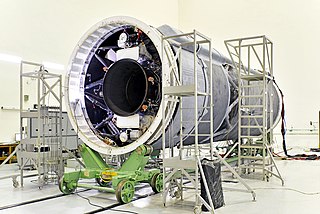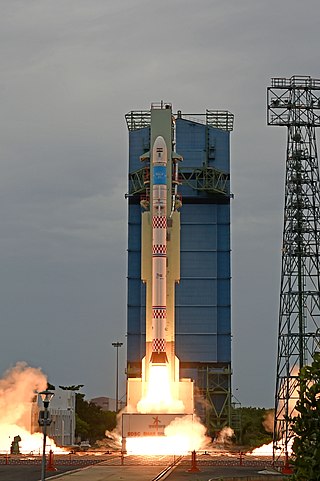
The Polar Satellite Launch Vehicle (PSLV) is an expendable medium-lift launch vehicle designed and operated by the Indian Space Research Organisation (ISRO). It was developed to allow India to launch its Indian Remote Sensing (IRS) satellites into Sun-synchronous orbits, a service that was, until the advent of the PSLV in 1993, only commercially available from Russia. PSLV can also launch small size satellites into Geostationary Transfer Orbit (GTO).

Geosynchronous Satellite Launch Vehicle (GSLV) is a class of expendable launch systems operated by the Indian Space Research Organisation (ISRO). GSLV has been used in fifteen launches since 2001.

The Indian Space Research Organisation is the national space agency of India. It operates as the primary research and development arm of the Department of Space (DoS), which is directly overseen by the Prime Minister of India while the Chairman of ISRO also acts as the executive of DoS. ISRO is primarily responsible for performing tasks related to space-based operations, space exploration, international space cooperation and the development of related technologies. ISRO is one of the six government space agencies in the world that possesses full launch capabilities, can deploy cryogenic engines, can launch extraterrestrial missions and operate a large fleet of artificial satellites. ISRO is one of the four government space agencies to have soft landing (uncrewed) capabilities.

Satish Dhawan Space Centre – SDSC, is the primary spaceport of the Indian Space Research Organisation (ISRO), located in Sriharikota, Andhra Pradesh.

The Liquid Propulsion Systems Centre (LPSC),Thiruvananthapuram is a research and development centre functioning under Indian Space Research Organisation (ISRO). It has two units located at Valiamala, in Thiruvananthapuram of Kerala, and Bengaluru of Karnataka. LPSC is augmented by ISRO Propulsion Complex at Mahendragiri of Tamil Nadu.

The Launch Vehicle Mark-3 or LVM3 is a three-stage medium-lift launch vehicle developed by the Indian Space Research Organisation (ISRO). Primarily designed to launch communication satellites into geostationary orbit, it is also due to launch crewed missions under the Indian Human Spaceflight Programme. LVM3 has a higher payload capacity than its predecessor, GSLV.

Gaganyaan is an Indian crewed orbital spacecraft intended to be the formative spacecraft of the Indian Human Spaceflight Programme. The spacecraft is being designed to carry three people, and a planned upgraded version will be equipped with rendezvous and docking capabilities. In its maiden crewed mission, the Indian Space Research Organisation (ISRO)'s largely autonomous 5.3-metric ton capsule will orbit the Earth at 400 km altitude for up to seven days with a two- or three-person crew on board. The first crewed mission was originally planned to be launched on ISRO's LVM3 rocket in December 2021. As of October 2023, it is expected to be launched by 2025.

The CE-20 is a cryogenic rocket engine developed by the Liquid Propulsion Systems Centre (LPSC), a subsidiary of the Indian Space Research Organisation (ISRO). It has been developed to power the upper stage of the LVM3. It is the first Indian cryogenic engine to feature a gas-generator cycle. The high thrust cryogenic engine is the most powerful upper stage cryogenic engine in operational service.

The CE-7.5 is a cryogenic rocket engine developed by the Indian Space Research Organisation to power the upper stage of its GSLV Mk-2 launch vehicle. The engine was developed as a part of the Cryogenic Upper Stage Project (CUSP). It replaced the KVD-1 (RD-56) Russian cryogenic engine that powered the upper stage of GSLV Mk-1.
Kerala Hitech Industries Limited (KELTEC) was an Indian aerospace company in Thiruvananthapuram, Kerala. Its product-mix included systems required for the launch vehicles, satellite and non-rotating systems of turbojet aircraft engines. KELTEC was acquired by BrahMos Aerospace and rebranded as Brahmos Aerospace Trivandrum Ltd (BATL) in 2007.
The ISRO Propulsion Complex (IPRC), located at Mahendragiri of Tamil Nadu, is an Indian Space Research Organisation (ISRO) centre involved in testing, assembling, and integrating propulsion systems and stages that are developed at ISRO's Liquid Propulsion Systems Centres. Formerly, IPRC was known as LPSC, Mahendragiri, functioning under LPSC. It was elevated as an independent centre and renamed as IPRC with effect from 1 February 2014.

The SCE-200 is a 2 MN thrust class liquid rocket engine, being developed to power ISRO's existing LVM3 and upcoming heavy and super heavy-lift launch vehicles. It is being developed by Liquid Propulsion Systems Centre (LPSC) of ISRO and is expected to have first flight in 2020s.
PSLV-C35 was the successful mission of the Polar Satellite Launch Vehicle program which set eight satellites in space. It was launched on 26 September 2016 by Indian Space Research Organisation (ISRO) from the Satish Dhawan Space Centre at Sriharikota.
PSLV-C5 was the fifth operational launch and overall eighth mission of the Polar Satellite Launch Vehicle program. This launch was also the fifty-second launch by the Indian Space Research Organisation (IRSO) since its first mission on 1 January 1962. The vehicle carried and injected India's remote sensing satellite Resourcesat-1 into a Sun-synchronous orbit; this was the heaviest and most sophisticated satellite built by IRSO through 2003. PSLV-C5 was launched at 04:52 hours Coordinated Universal Time on 17 October 2003 from Satish Dhawan Space Centre.

GSAT-6A was a communication satellite launched by the Indian Space Research Organisation (ISRO) It featured a 6-metre (20 ft) unfurlable S-band antenna similar to the one used on GSAT-6. Around 17 minutes after lift-off, the three stage GSLV Mk.II rocket flying on GSLV F08 mission successfully injected the satellite into a geosynchronous transfer orbit. Due to power failure during its orbit raising burns the communication was lost with GSAT-6A before it could reach its final circular geostationary orbit (GSO).

The Small Satellite Launch Vehicle (SSLV) is a small-lift launch vehicle developed by ISRO with payload capacity to deliver 500 kg (1,100 lb) to low Earth orbit or 300 kg (660 lb) to Sun-synchronous orbit for launching small satellites, with the capability to support multiple orbital drop-offs. SSLV is made keeping low cost, low turnaround time in mind with launch-on-demand flexibility under minimal infrastructure requirements.

The GSLV F12 is the 15th flight of the GSLV and the 9th flight of Mk2 variant using indigenous Cryogenic engine.
The Next Generation Launch Vehicle or NGLV is a three-stage partially reusable rocket, currently under development by the Indian Space Research Organisation (ISRO). This vehicle is designed to replace currently operational systems like PSLV, GSLV and LVM3.
















